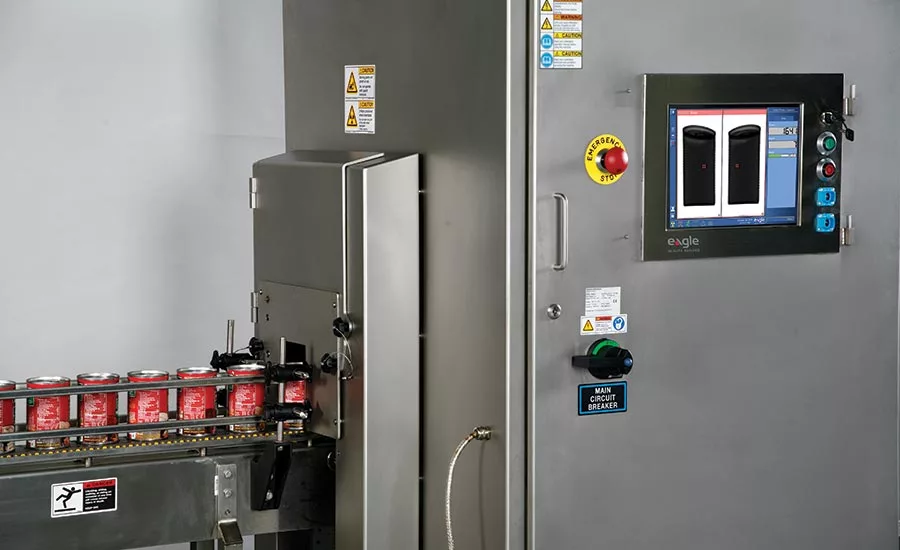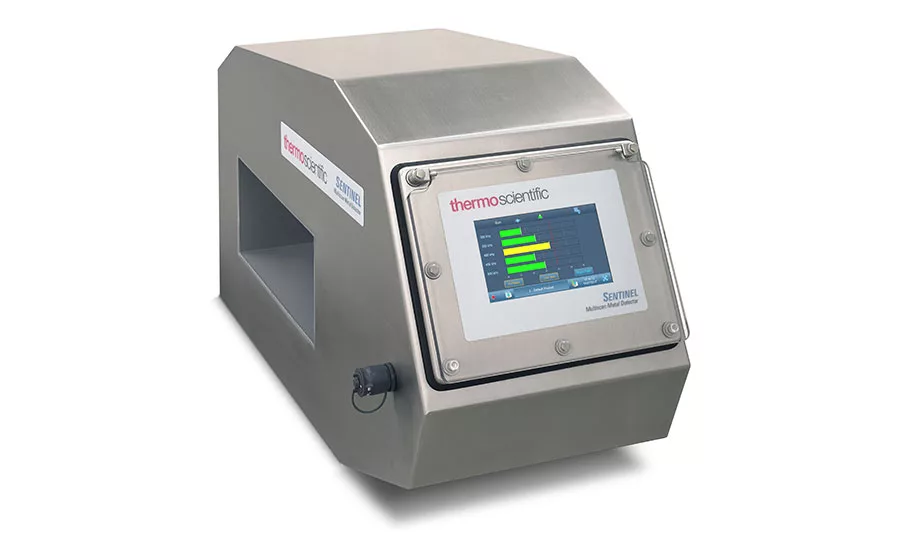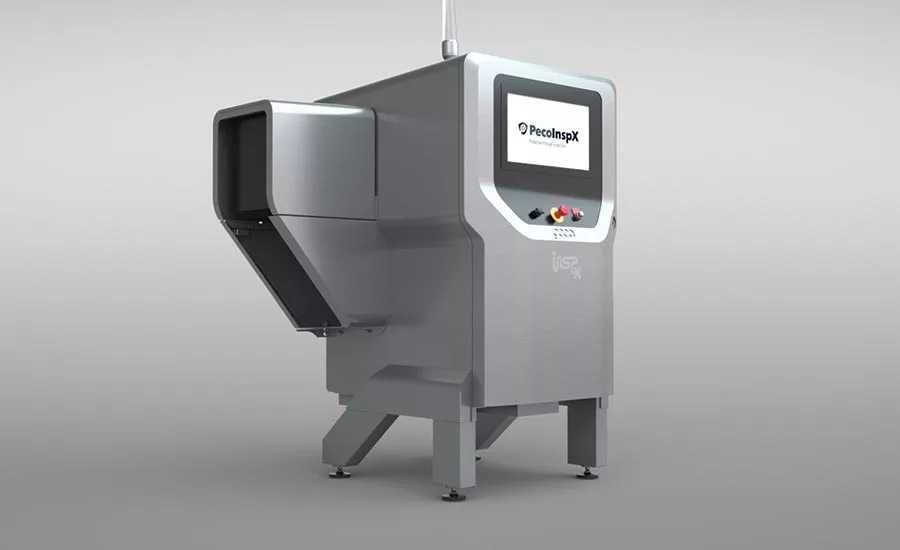Tech Update
How to choose X-ray and metal detection equipment
Concentrating on food safety and quality goals for your products helps determine the right choice in inspection systems.

The Eagle Tall PRO XSDV simultaneously performs contaminant detection, fill level inspection and mass measurement in metal cans and other tall, rigid containers.
Photo courtesy of Eagle Product Inspection

The METTLER TOLEDO Profile Advantage metal detector employs multi-simultaneous frequency technology to reduce product effect.
Photo courtesy of METTLER TOLEDO

The Thermo Scientific Sentinel multiscan metal detector enables users to identify contaminants that are up to 70 percent smaller in volume than previous technologies.
Photo courtesy of Thermo Fisher Scientific

Peco-InspX recently introduced a new line-up of X-ray machines called the SHIELD, which offer major advancements in detection capability and ease of use.
Photo courtesy of Peco-InspX
Food safety and quality assurance have always been important for processors, but with increasing retailer demands, high consumer expectations and stricter governmental regulations, they are absolutely critical. If foreign material is found in a packaged food or beverage product produced at your facility, then your brand or business is potentially facing a PR storm or much worse.
Both X-ray and metal detection machines can prevent a lot of headaches. But if this is your first time purchasing a system, determining which is right for your operations can be confusing, since you need to consider all factors, such as cost and life expectancy. Or perhaps, your plant is looking for a new replacement model or upgrade. The following article has some tips and advice to help you make the right detection system choice.
Influencing the need
In today’s food and beverage processing operations, ensuring all food and beverage products are free of potential foreign material is critical for processors. That process begins even before ingredients and materials are used in your facility.
“Contamination threats exist at all steps of the food chain, so it is up to processors to protect consumers from the start,” says Bob Ries, lead product manager of X-ray inspection and metal detection for Thermo Fisher Scientific.
Keeping products free of contaminants is important for protecting a food and beverage company’s reputation and the consumer, of course, but it is also crucial for the operation’s food safety plan.
“Retailers are increasingly wary of protecting the reputation of their brands, as product recalls can be extremely damaging and very costly,” says Christy Draus, marketing manager for Eagle Product Inspection. “Consumer expectations, too, continue to be high due to the sheer amount of information that is available to them.”
Consumers are increasingly interested in knowing how a product is produced, its provenance and the procedures and processes it undergoes, she says. People now expect only the highest-quality products to make their way onto the retail shelf, and with social media, it is easier for consumers to publicize any dissatisfaction.
“The ready access to social media channels means that even the smallest lapse in quality control can quickly become public knowledge and, therefore, start to have an immediate effect on brand reputation,” Draus says.
And then, there is the governmental regulations piece of this pressure trifecta. Traditionally, inspection systems have often been identified as critical control points within processors’ Hazard Analysis Critical Control Points (HACCP) programs. However, the introduction of the Food Safety Modernization Act tweaked the inspection process a bit.
“FSMA introduced the concept of Preventative Controls, and the result is that facilities are looking throughout their entire value chain and identifying Preventative Control locations earlier in the manufacturing process,” says Robert Rogers, METTLER TOLEDO’s senior advisor for food safety and regulation.
So, instead of inspections systems being placed at the very end of the process, processors are moving them further up the production line. Thus, contamination is being detected earlier, which, Rogers says, helps reduce waste and improve efficiencies, because the placement more accurately identifies root causes of problems.
And for high-speed and high-volume lines, an automatic detection system is absolutely necessary, because end-of-line visual inspection is just not possible, says Tony Bryant, managing director, UK/Europe for Peco InspX.
Metal detection and X-ray
Rather than focus on which type of system, metal detector or X-ray machine is better, it might be more useful not to compare, but to understand the differences.
“Which technology is best suited to a particular operation will depend largely on the results of a HACCP audit and the types of contaminants a manufacturer is expected to encounter,” says Draus. “If, for example, metal is the only concern, it stands to reason that a metal detector could be deployed at a critical control point.”
But if there is the potential for other types of contaminants, such as stone, glass, bone, rubber and plastic, to get into the product, then X-ray might be the way to go.
The type of packaging being used in facilities is another important factor. If a processor is using packaging that is metallized, such as cans or foil pouches, then the inspection system required would most likely be X-ray, says Emmett Keim, regional sales manager for Anritsu Invifis Inc.
However, according to METTLER TOLEDO’s white paper entitled “Metal Detection, X-ray or Both?,” products packed in metallized film packaging usually can be inspected by metal detectors using low-frequency operation, unless the film is particularly thick. Products in aluminum packaging can pose a bigger problem for metal detectors using balanced coil technology, since the inspection system won’t work. In these cases, a different technology, known as “ferrous in foil” detection, which employs magnets, must be used.
There are a variety of food and beverage products that are well suited for metal detection systems, including loose products, pumped products (like liquids and pastes) and dry, bulk powders and solids. Tall containers, like bottles and jars, can be inspected with metal detectors, as long as they don’t have metal caps or closures.
On the other hand, X-ray systems offer a wide range of capabilities to detect a variety of contaminants.
“Single-energy X-ray inspection technology, for example, is used to inspect food products for contamination and is very effective at detecting foreign bodies that exhibit an X-ray absorption spike, relative to the surrounding product’s absorption,” says Draus.
These systems can detect stainless steel, ferrous and non-ferrous metals, as well as glass, calcified bone, mineral stone and high-density plastics and rubber. However, if a processor needs to detect foreign bodies in dense products, then this is more easily done with dual-energy technology.
“Dual-energy technology is better at detecting objects that show a very small X-ray absorption variation,” Draus says. “For example, dual-energy makes it possible to detect flat glass and stone in mixed nuts, both of which can be challenging to detect using single-energy detectors.”
Detection capabilities and false rejection rates of any inspection system should be carefully considered by prospective buyers, says Bryant. Just because a system’s sensitive doesn’t mean it’s useful, if it has a high rate of false rejections.
“X-ray systems continue to make material advancements in terms of their ability to find foreign materials and in reducing the instance of false rejects,” he says. “X-ray can inspect pretty much all food and beverage products, from large boxes to small chocolates. X-ray systems will commonly find 1-mm metal and 3-mm glass and stone in non-rigid containers.”
Despite all these considerations, choosing the type of product inspection system to buy, in the end, might be out of the processor’s hands entirely.
“Some major retailers are demanding X-ray product inspection as a minimum requirement where product inspection is concerned,” says Draus. “Therefore, companies wishing to do business with these firms have little option but to invest [in X-ray].”
New improvements and capabilities
The capabilities of both X-ray and metal detection inspection systems are being improved. For example, Anritsu has a new XR75 series of X-ray systems. Keim says these systems have an improved “signal-to-noise ratio” that allows them to detect more types of contaminants than in the past.
“The ability to see more within the product allows Anritsu X-ray systems to better analyze the products for virtual weight analysis, missing items, broken items and seal checks,” he says. “X-ray has improved on CPU processing power to allow for higher or faster production throughput.”
METTLER TOLEDO’s Safeline X3000 X-ray system series employs advanced algorithms to provide better detection levels, says Lanel Menezes, product manager for X-ray.
“The advanced algorithms mean we can simplify inspection setup with a simple auto-learn feature, making it operator friendly,” he says.
Making X-ray machines easier to operate has been a major area of improvement for equipment providers. Machine-based learning has come into play where the machine can dynamically learn how to improve the inspection process, says Bryant.
“This and similar types of software automation make the machines much easier to set up and use,” he says.
Processors are also looking for more ways to improve operational excellence and overall equipment effectiveness (OEE), so X-ray systems are increasingly offering these capabilities. For instance, Menezes says, X-ray software can provide product/package integrity checks, such as identification of missing components, clip detection for chub applications, fill level, mass analysis, missing caps, etc.
“New X-ray systems can offer immense insight into the operational efficiency of a production line and help processors meaningfully improve their productivity,” says Bryant. “For example, an X-ray system can tell a processor that they have a high rate of defect products produced very slowly during a specific shift.”
This information can be used to drive better utilization and production yields in plants.
Additionally, for the meat processing industry, Draus says Eagle’s Fat Analysis technology uses DEXA technology or dual-energy X-ray absorptiometry, which measures chemical lean values of meat products, to inspect 100 percent of meat passing through the production line. Plus, it offers OPTUM software for batch formulation and recipe control.
“Taking the guesswork out of meat recipe management and batching to a target chemical lean also allow customers to maximize profits,” says Draus.
Not to be overshadowed, metal detection systems’ inspection technology has been improved as well.
“New concepts within the industry are using simultaneous frequencies to enhance metal signal detection and removing the analog circuitry of the past to replace [it] with a more reliable, all-digital circuity,” says Keim.
In the past, metal detectors have been criticized for having the so-called “product effect.” Meat, dairy, bread and more have been cited as examples of where product effect would influence and possibly compromise detection levels. However, there are advances in preventing product effect.
“Today’s metal detectors feature multi-frequency detection, employing multiple frequencies to overcome what is known as ‘product effect’—the signals sent by the moisture or changing temperature in a product that mimic metal contamination,” says Camilo Sanchez, product manager of metal detection for METTER TOLEDO. “This greatly reduces false rejects that result in costly product losses.”
Multiscan technology, says Thermo Fisher Scientific’s Ries, is designed to dramatically reduce the risk of metal contaminants escaping a facility. With more traditional single- and dual-frequency detectors, the performance was more unreliable and limited in its metal detection capabilities.
“By using a multiscan metal detector, however, manufacturers can scan through up to five frequencies at once, separating the contaminant signal from the product signal and, thus, increasing the probability of detection of a random object embedded in a product,” Ries says.
As a result, multiscan metal detectors are able to pick up smaller metal objects than their traditional counterparts. They also detect metal in products like iron-fortified cereal and wet spinach, which have properties that make them appear magnetic and conductive when subjected to electromagnetic fields.
“Previously, the difficulties associated with ignoring the product and various facility noise sources to focus on detecting small signals resulted in numerous compromises on the part of food processors,” says Ries.
Additionally, the latest generation of metal detectors have color touchscreens and can display operating data graphically, adds Ries, which makes them easier to use and tune. Plus, now metal detectors have computers embedded in them, so detailed product data can be saved and offloaded from the machines to help provide important information for production, auditing and possible contamination events.
Cost, life expectancy and other considerations
Cost is always a factor that has to be considered. And there are some obvious price differences.
“Metal detection is typically a lower-cost solution to ensure the processor is within FSMA compliance,” says Keim.
However, X-ray systems are getting increasingly more affordable.
“The total cost of ownership [TCO] of X-ray systems has come down markedly in the last several years,” says Bryant.
That’s a good thing, because as Draus points out, processors are becoming more and more concerned about the reliability and longevity of the systems they invest in.
“System durability (affects) TCO and, as such, can have a significant impact on a manufacturer’s bottom line,” she says.
To ensure its machines have a long lifespan, Draus says Eagle Product Inspection’s detection systems and components are designed to be placed into specific environments depending on product and packaging type. So, the systems can handle rough conditions, such as harsh washdown practices.
“The systems are highly robust, are designed to go into harsh environments and require relatively minimal intervention,” she says.
However, TCO shouldn’t be the only consideration when deciding what type of inspection system is best for a facility. Processors need to take stock of all the potential hazards posed on the production line and critically look at the advantages and disadvantages of both X-ray and metal detection.
“Determining whether metal detectors, X-ray inspection or optical systems are ‘best’ in any given case depends on a variety of factors,” says Ries.
In some instances, a metal detector is sufficient for a manufacturer’s needs.
“However, if additional functions are required, such as fill level detection, component counts, mass measurement or checking the integrity of product seals for trapped product or deformity, it makes perfect sense to implement a system that is capable of performing all of these tasks simultaneously as product passes down the production line,” Draus says.
Some plants do employ multiple types of detection systems, which would be ideal in many circumstances, but may not be realistic for others.
“If money was no object, and space wasn’t an issue, it would make perfect sense to install one of every detection system available,” says Bryant. “But this is certainly not the case. Money is tight and space [is at] a premium for most food and beverage companies. Therefore, look for the best ‘bang for the buck’ with the least amount of line disruption and cost.”
Regardless of the inspection equipment chosen, its use and placement should be designed around the risks the security system as a whole is trying to minimize or eliminate.
“Whatever the application, inspection of the product should be done as close as possible to the point in the line where the flow or product is smallest or slowest,” says Ries. “This will always yield the highest sensitivity and least amount of scrap or rework.”
For more information:
Robert Rogers, METTLER TOLEDO, 800-447-4439,
pi.marketing@mt.com, www.mt.com/pi
Christy Draus, Eagle Product Inspection, 877-379-1670,
eaglesales@eaglepi.com, www.eaglepi.com
Tony Bryant, Peco-InspX, 877-722-6875,
info@peco-inspx.com, www.peco-inspx.com
Emmett Keim, Anritsu Infivis Inc., 847-419-9729,
www.anrtisu.com
Bob Ries, Thermo Fisher Scientific, 763-783-2500,
www.thermofisher.com/productinspection
Looking for a reprint of this article?
From high-res PDFs to custom plaques, order your copy today!





